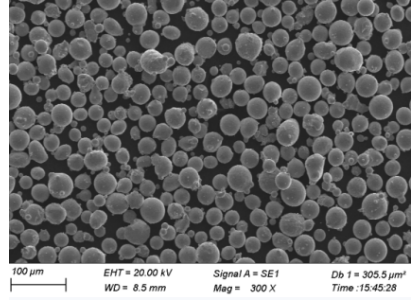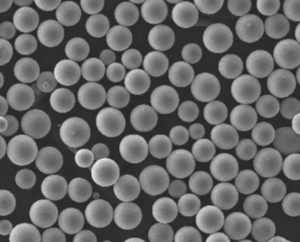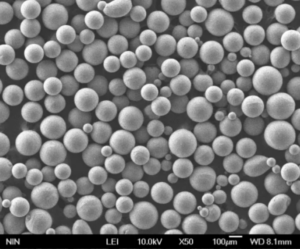Überblick über Selektives Schmelzen mit Elektronenstrahl
Electron Beam Selective Melting (EBSM) ist eine fortschrittliche additive Fertigungstechnologie, die einen Elektronenstrahl verwendet, um Metallpulver schichtweise selektiv zu schmelzen und so komplexe 3D-Strukturen zu erzeugen. Diese Technologie eignet sich besonders für Hochleistungswerkstoffe und Anwendungen, die überlegene Festigkeit, Präzision und Materialintegrität erfordern. In diesem umfassenden Leitfaden werden wir uns mit den Besonderheiten von EBSM befassen, verschiedene Metallpulvermodelle untersuchen, die in diesem Verfahren verwendet werden, und detaillierte Informationen über die Ausrüstung, ihre Eigenschaften, Anwendungen und Lieferanten liefern.
Was ist Electron Beam Selective Melting?
EBSM ist ein Verfahren, bei dem ein Elektronenstrahl auf ein Bett aus Metallpulver gerichtet wird, wodurch dieses schmilzt und miteinander verschmilzt. Dieser Vorgang wird Schicht für Schicht wiederholt, bis das endgültige 3D-Objekt fertiggestellt ist. Im Gegensatz zu anderen additiven Fertigungsverfahren bietet EBSM außergewöhnliche Präzision und Materialeigenschaften, was es ideal für kritische Industrien wie Luft- und Raumfahrt, Automobil und medizinische Implantate macht.
Hauptmerkmale der Electron Beam Selective Melting-Ausrüstung
- Hohe Präzision: EBSM erreicht hohe Genauigkeit und komplizierte Details durch die feine Steuerung des Elektronenstrahls.
- Vielseitigkeit der Materialien: Kann eine breite Palette von Metallpulvern verarbeiten.
- Hervorragende mechanische Eigenschaften: Die hergestellten Teile weisen eine ausgezeichnete Festigkeit und Haltbarkeit auf.
- Reduzierte Eigenspannung: Das Verfahren minimiert innere Spannungen im Endprodukt.
- Effiziente Materialausnutzung: Hohe Materialausnutzungsrate bei minimalem Abfall.

Arten von Metallpulvern für das Elektronenstrahlschmelzen
Die Wahl des Metallpulvers ist beim EBSM entscheidend, da sie sich direkt auf die Qualität und die Eigenschaften des Endprodukts auswirkt. Hier listen wir spezifische Metallpulvermodelle auf und beschreiben ihre Zusammensetzung und Eigenschaften.
Beliebte Metallpulvermodelle für EBSM
- Ti-6Al-4V (Titanlegierung)
- Zusammensetzung: 6 % Aluminium, 4 % Vanadium, Rest Titan
- Eigenschaften: Hohes Verhältnis von Festigkeit zu Gewicht, hervorragende Korrosionsbeständigkeit, Biokompatibilität
- Anwendungen: Komponenten für die Luft- und Raumfahrt, medizinische Implantate
- Inconel 718 (Nickel-Chrom-Legierung)
- Zusammensetzung: Nickel 50-55 %, Chrom 17-21 %, Eisen, Niob, Molybdän
- Eigenschaften: Hochtemperaturfestigkeit, Oxidationsbeständigkeit, gute Schweißbarkeit
- Anwendungen: Turbinenschaufeln, Raketentriebwerke, Kernreaktoren
- AlSi10Mg (Aluminiumlegierung)
- Zusammensetzung: 10 % Silizium, 0,3 % Magnesium, Rest Aluminium
- Eigenschaften: Leichtgewicht, gute thermische Eigenschaften, ausgezeichnetes Festigkeits-Gewichts-Verhältnis
- Anwendungen: Automobilteile, Luft- und Raumfahrtkomponenten, Leichtbaustrukturen
- 316L-Edelstahl
- Zusammensetzung: Eisen, 16-18 % Chrom, 10-14 % Nickel, 2-3 % Molybdän
- Eigenschaften: Hohe Korrosionsbeständigkeit, ausgezeichnete Duktilität, gute mechanische Eigenschaften
- Anwendungen: Medizinische Geräte, chemische Verarbeitungsausrüstung, Anwendungen im maritimen Bereich
- CoCr (Kobalt-Chrom-Legierung)
- Zusammensetzung: 60 % Kobalt, 27-30 % Chrom, Rest Molybdän, Nickel
- Eigenschaften: Hohe Verschleißfestigkeit, ausgezeichnete Korrosionsbeständigkeit, Biokompatibilität
- Anwendungen: Zahnimplantate, orthopädische Implantate, Komponenten für die Luft- und Raumfahrt
- Martensitaushärtender Stahl
- Zusammensetzung: 18 % Nickel, 8-12 % Kobalt, Rest Eisen
- Eigenschaften: Ultrahohe Festigkeit, ausgezeichnete Zähigkeit, gute Schweißbarkeit
- Anwendungen: Werkzeuge, Luft- und Raumfahrtkomponenten, Anwendungen mit hoher Festigkeit
- Hastelloy X (Nickel-Chrom-Molybdän-Legierung)
- Zusammensetzung: Nickel, 20-23 % Chrom, 8-10 % Molybdän, 1,5-2,5 % Kobalt
- Eigenschaften: Ausgezeichnete Hochtemperaturfestigkeit, Oxidationsbeständigkeit
- Anwendungen: Gasturbinentriebwerke, chemische Verarbeitung, Wärmetauscher
- Niobium
- Zusammensetzung: Reines Niobium
- Eigenschaften: Hoher Schmelzpunkt, ausgezeichnete Korrosionsbeständigkeit, gute Biokompatibilität
- Anwendungen: Supraleiter, medizinische Geräte, Luft- und Raumfahrtkomponenten
- Kupfer
- Zusammensetzung: Reines Kupfer
- Eigenschaften: Ausgezeichnete elektrische und thermische Leitfähigkeit, gute Duktilität
- Anwendungen: Elektronische Bauteile, Wärmetauscher, Kühler
- Werkzeugstahl
- Zusammensetzung: Variiert (enthält üblicherweise Kohlenstoff, Chrom, Vanadium, Molybdän)
- Eigenschaften: Hohe Härte, ausgezeichnete Verschleißfestigkeit, gute Zähigkeit
- Anwendungen: Schneidwerkzeuge, Formen, Matrizen
Merkmale von Selektives Schmelzen mit Elektronenstrahl
EBSM-Geräte sind darauf ausgelegt, hohe Präzision und Effizienz in der additiven Fertigung zu gewährleisten. Hier sind einige wesentliche Merkmale dieser Geräte:
Hauptkomponenten
- Elektronenstrahlkanone: Erzeugt und lenkt den Elektronenstrahl mit hoher Präzision.
- Baukammer: Umschließt den Bauraum und hält ein Vakuum oder eine Inertgasatmosphäre aufrecht.
- Pulverspender: Verteilt Metallpulver gleichmäßig über den Bauraum.
- Beschichterklinge: Verteilt jede Pulverschicht gleichmäßig.
- Kontrollsystem: Verwaltet die Parameter des Elektronenstrahls und des Bauprozesses.
Wesentliche Merkmale
| Charakteristisch | Beschreibung |
|---|---|
| Größe bauen | Typischerweise von klein (100 mm) bis groß (1000 mm) in einer oder mehreren Dimensionen. |
| Auflösung | Hohe Auflösung mit einer Schichtdicke von 20 bis 100 Mikrometern. |
| Strombedarf | Benötigt erhebliche elektrische Leistung, oft im Bereich von mehreren Kilowatt. |
| Atmosphärenkontrolle | Verwendet ein Vakuum oder Inertgas (wie Argon), um Oxidation und Kontamination zu verhindern. |
| Software-Integration | Fortschrittliche Software für Design, Simulation und Steuerung, die eine präzise Einhaltung des CAD-Modells gewährleistet. |
| Kühlsystem | Effiziente Kühlsysteme zur Bewältigung der Wärme, die während des Schmelzprozesses entsteht. |
| Kompatibilität der Materialien | Kann eine Vielzahl von Metallpulvern verarbeiten, darunter Titan, Aluminium, Edelstahl und Nickelbasis-Superlegierungen. |






Anwendungen von Electron Beam Selective Melting Equipment
Die EBSM-Technologie ist vielseitig und wird in verschiedenen Branchen eingesetzt. Hier sind einige gängige Anwendungen:
Industrielle Anwendungen
| Industrie | Anwendungen |
|---|---|
| Luft- und Raumfahrt | Motorkomponenten, Strukturteile, komplexe Geometrien, Leichtbaumaterialien |
| Automobilindustrie | Motorteile, kundenspezifische Komponenten, Leichtbaustrukturen |
| Medizinische | Orthopädische Implantate, Zahnimplantate, chirurgische Instrumente |
| Energie | Turbinenschaufeln, Wärmetauscher, Komponenten für Kernreaktoren |
| Verteidigung | Leichte Panzerung, Waffenkomponenten, UAV-Teile |
| Werkzeugbau | Formen, Gesenke, Schneidwerkzeuge |
| Elektronik | Kühlkörper, elektronische Bauteile, Steckverbinder |
Detaillierte Anwendungen
- Luft- und Raumfahrtkomponenten: EBSM wird zur Herstellung von leichten und komplexen Luft- und Raumfahrtteilen verwendet, wodurch Materialabfall reduziert und die Leistung verbessert wird.
- Medizinische Implantate: Die Fähigkeit, komplizierte Designs mit biokompatiblen Materialien zu erstellen, macht EBSM ideal für die Herstellung von kundenspezifischen Implantaten.
- Automobilteile: Hochleistungs- und Leichtbaukomponenten können hergestellt werden, um die Kraftstoffeffizienz und die Leistung in Fahrzeugen zu verbessern.
- Energiesektor: Turbinenschaufeln und Wärmetauscher profitieren von der hohen Festigkeit und Temperaturbeständigkeit der mit EBSM hergestellten Teile.
- Werkzeuge: Präzisionsformen und -werkzeuge werden mit außergewöhnlicher Haltbarkeit und Verschleißfestigkeit hergestellt.
Spezifikationen und Normen für Selektives Schmelzen mit Elektronenstrahl
Um Qualität und Konsistenz zu gewährleisten, müssen EBSM-Geräte bestimmte Spezifikationen und Standards einhalten.
Spezifikationen der EBSM-Ausrüstung
| Spezifikation | Beschreibung |
|---|---|
| Volumen aufbauen | Variabel, typischerweise 200 x 200 x 200 mm bis 700 x 700 x 400 mm |
| Schichtdicke | 20-100 Mikrometer |
| Strahlleistung | 3-10 kW |
| Scan-Geschwindigkeit | Bis zu 8 m/s |
| Auflösung | ± 0,1 mm |
| Atmosphärenkontrolle | Vakuum oder Inertgas (z. B. Argon) |
| Software | Integrierte CAD/CAM-Software mit Echtzeitüberwachung und -steuerung |
Standards für EBSM-Geräte
| Standard | Beschreibung |
|---|---|
| ASTM F3187 | Standardleitfaden für das additive Fertigungsverfahren des Elektronenstrahlschmelzens |
| ISO/ASTM 52900 | Standardterminologie für die additive Fertigung |
| ISO 13485 | Qualitätsmanagementsysteme für Medizinprodukte |
| AS9100 | Qualitätsmanagementsysteme für die Luft- und Raumfahrt |
| ISO 9001 | Allgemeine Qualitätsmanagementstandards |
Lieferanten und Preisangaben
Bei der Beschaffung von EBSM-Geräten ist es wichtig, seriöse Lieferanten zu berücksichtigen und die Preise zu vergleichen.
Liste der Lieferanten und Preise
| Anbieter | Geräte-Modell | Preisspanne | Kontaktinformationen |
| Arcam (GE Additive) | Arcam EBM Q10plus | $500,000 – $1,000,000 | www.ge.com/additive |
| Sciaky Inc. | EBAM 300 Serie | $1,000,000 – $2,500,000 | www.sciaky.com |
| Renishaw | RenAM 500E | $600,000 – $1,200,000 | www.renishaw.com |
| Freemelt | Freemelt ONE | $400,000 – $800,000 | www.freemelt.com |
| Additive Industrien | MetallFAB1 | $800,000 – $1,500,000 | www.additiveindustries.com |
| Xi’an Bright Laser | EP-M250 | $500,000 – $1,000,000 | www.xbmetal.com |
| Aerosint | Multi-Material EBM | $700,000 – $1,400,000 | www.aerosint.com |
| 3D Systems | DMP Flex 350 | $500,000 – $1,200,000 | www.3dsystems.com |
| Trumpf | TruPrint 3000 | $700,000 – $1,300,000 | www.trumpf.com |
| EOS | EOS M 290 | $600,000 – $1,100,000 | www.eos.info |
Vergleich der
EBSM hat eindeutige Vorteile und einige Einschränkungen. Hier vergleichen wir sie, um eine ausgewogene Perspektive zu bieten.
Vorteile und Nachteile von EBSM
| Aspekt | Vorteile | Benachteiligungen |
|---|---|---|
| Präzision | Hohe Genauigkeit und komplizierte Details | Erfordert präzise Steuerung und Überwachung |
| Materialeigenschaften | Überlegene mechanische Eigenschaften, reduzierter Eigenspannungsgehalt | Beschränkt auf Materialien, die mit Elektronenstrahlbearbeitung kompatibel sind |
| Baugeschwindigkeit | Schnellere Bauzeiten im Vergleich zu einigen anderen additiven Fertigungsverfahren | Kann für sehr große Teile langsamer sein |
| Materialeffizienz | Hohe Materialausnutzung mit minimalem Abfall | Pulverhandhabung und -recycling können komplex sein |
| Operative Kosten | Kosteneffektiv für hochwertige und komplexe Teile | Hohe Anfangsinvestitionen und Betriebskosten |
| Komplexität | Fähigkeit zur Herstellung hochkomplexer Geometrien | Erfordert Fachwissen in Design und Prozessparametern |
| Nachbearbeitung | Im Allgemeinen weniger Nachbearbeitung erforderlich als bei anderen Verfahren | Einige Teile erfordern möglicherweise noch Nachbearbeitungsprozesse wie z. B. Zerspanung |
| Vielseitigkeit | Geeignet für eine Vielzahl von Anwendungen von der Luft- und Raumfahrt bis zur Medizin | Nicht geeignet für nichtmetallische Materialien |
| Atmosphärenkontrolle | Kontrollierte Atmosphäre gewährleistet hochwertige Teile ohne Oxidation | Die Aufrechterhaltung von Vakuum oder Inertgasatmosphäre kann technisch anspruchsvoll sein |
Optimierung der Absatzstruktur für ein besseres Engagement
Beim Schreiben über technische Themen wie EBSM ist es wichtig, den Leser zu fesseln. Lassen Sie uns untersuchen, wie man dies effektiv tut.
Verwendung eines umgangssprachlichen Tons und eines ansprechenden Stils
Stellen Sie sich vor, Sie sind auf einer Dinnerparty und erklären EBSM einem Freund, der sich für 3D-Druck interessiert. Sie würden doch nicht gleich mit Fachjargon anfangen, oder? Stattdessen würden Sie mit etwas beginnen, das nachvollziehbar ist, wie z. B.: „Haben Sie sich jemals gefragt, wie sie diese superkomplexen Teile für Strahltriebwerke herstellen? Nun, es gibt diese unglaubliche Technologie namens Elektronenstrahl-Selektivschmelzen…“
Indem Sie komplexe Informationen in verdauliche Häppchen zerlegen und Analogien, Metaphern und rhetorische Fragen verwenden, halten Sie das Interesse des Lesers aufrecht. So könnte man beispielsweise die Präzision von EBSM damit vergleichen, „mit einem feinen Stift im Vergleich zu einem Wachsmalstift zu zeichnen – der Elektronenstrahl ist der Stift, der Ihnen komplizierte Details und glatte Kanten liefert“.

FAQ
| Frage | Antwort |
|---|---|
| Welche Materialien können mit EBSM verwendet werden? | EBSM kann eine Vielzahl von Metallpulvern verarbeiten, darunter Titanlegierungen, Nickelbasis-Superlegierungen, Aluminiumlegierungen, Edelstahl, Kobalt-Chrom-Legierungen und mehr. |
| Wie vergleicht sich EBSM mit anderen 3D-Druckverfahren? | EBSM bietet im Vergleich zu Verfahren wie SLM (Selektives Laserschmelzen) oder DMLS (Direktes Metall-Lasersintern) überlegene mechanische Eigenschaften, Präzision und einen reduzierten Eigenspannungsgehalt. |
| Was sind die gängigen Anwendungen von EBSM? | Zu den gängigen Anwendungen gehören Komponenten für die Luft- und Raumfahrt, medizinische Implantate, Automobilteile, Komponenten für den Energiesektor und Werkzeuge. |
| Ist EBSM für die Großserienproduktion geeignet? | EBSM wird aufgrund seiner Präzision und Materialeffizienz typischerweise für hochwertige, komplexe Teile und nicht für die Großserienproduktion verwendet. |
| Welche Nachbearbeitung ist für EBSM-Teile erforderlich? | Je nach Anwendung können EBSM-Teile eine minimale Nachbearbeitung wie Zerspanung, Polieren oder Wärmebehandlung erfordern, um die gewünschte Oberfläche und die gewünschten Eigenschaften zu erzielen. |
Schlussfolgerung
Elektronenstrahl-Selektivschmelzen stellt einen bahnbrechenden Fortschritt in der additiven Fertigung dar. Seine Fähigkeit, komplexe Hochleistungsteile mit Präzision und Effizienz herzustellen, macht es in verschiedenen Branchen unschätzbar wertvoll. Durch das Verständnis der Arten von Metallpulvern, der Eigenschaften der Ausrüstung und der vielfältigen Anwendungen können wir das transformative Potenzial der EBSM-Technologie würdigen. Ob Sie Ingenieur, Hersteller oder einfach nur ein Technikbegeisterter sind, die Welt von EBSM ist voller Möglichkeiten und gestaltet die Zukunft der Fertigung, einen Elektronenstrahl nach dem anderen.

